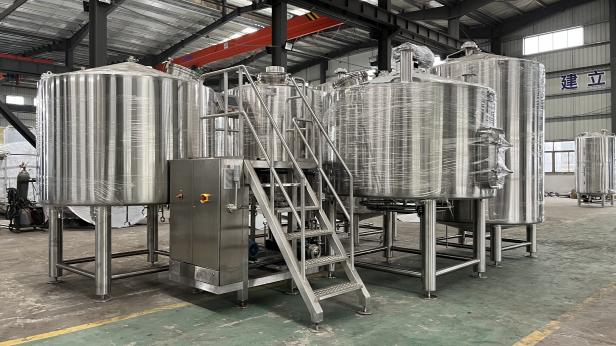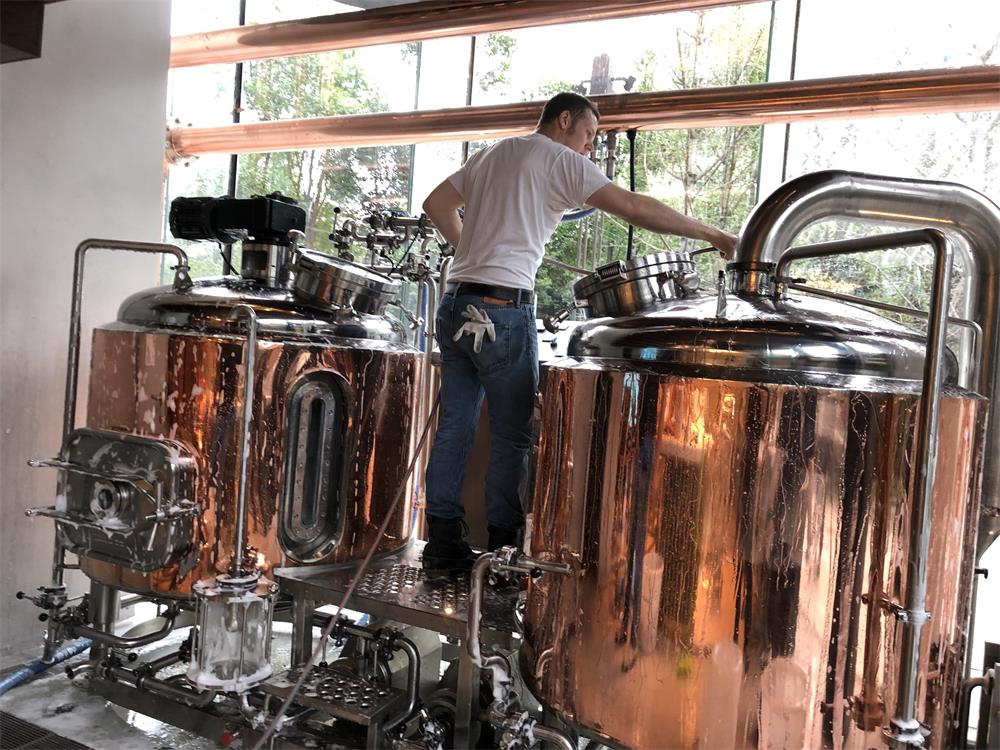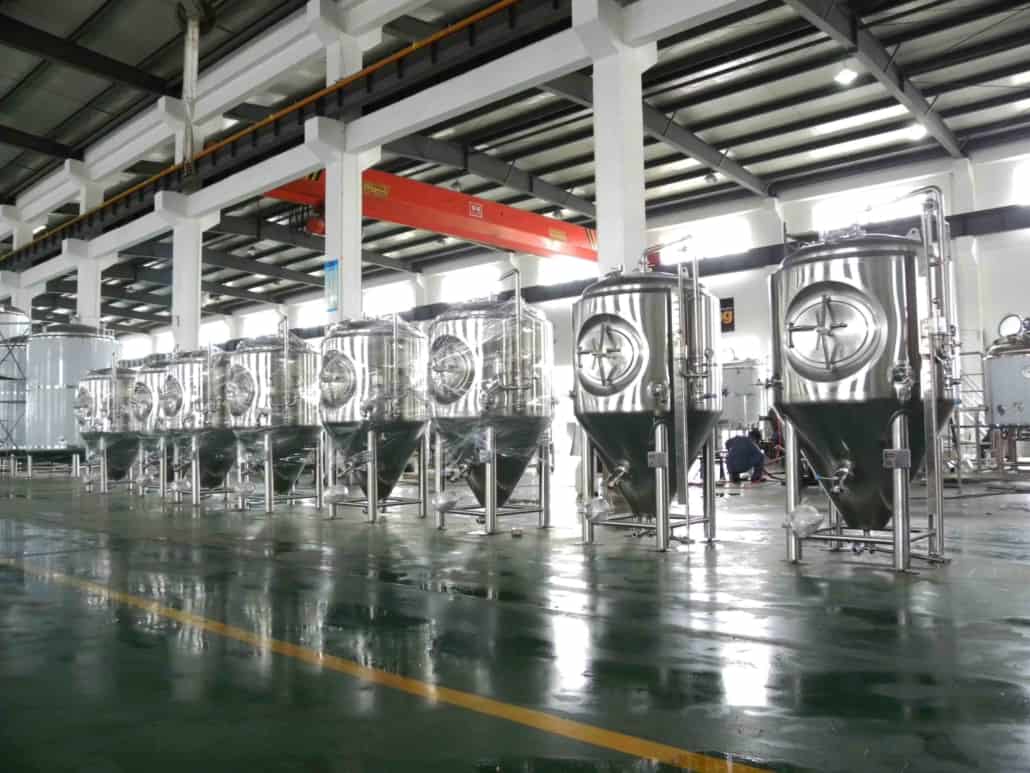Overview of 15 BBL Fermenter
A 15 barrel (BBL) fermenter is a large fermentation vessel used by commercial craft breweries and microbreweries. It has a capacity of 15 barrels or 465 gallons (1,760 liters). 15 BBL fermenters allow small to mid-sized breweries to increase production to meet growing demand while retaining flexibility for craft batches.
This guide covers different types of 15 BBL fermenters, design considerations, suppliers and pricing, installation and operation, how to select the right system, and pros, cons and limitations to consider.
Types of 15 BBL Fermenter
There are two main types of 15 BBL fermenters used in craft brewing operations:
| Type | Description |
|---|---|
| Stainless Steel | Most common type, made completely from stainless steel. Durable, easy to clean and sanitize. More expensive than plastic but lasts much longer. |
| Plastic (HDPE) | Made from High Density Polyethylene plastic. Lower cost but still food-grade and durable. Limitations on pressure ratings. |
Stainless steel is generally preferred for its longer lifespan, durability, and flexibility to add valves, ports or integrated cooling. Plastic vessels can provide an economic large volume fermentation option.

Design Considerations for 15 BBL Fermenter
Key design factors to consider for a 15 BBL fermentation system:
| Design Choice | Options | Details |
|---|---|---|
| Shape | – Cylindrical – Conical | Conical bottom allows sediment to settle for easier transfers and harvesting. Cylindrical vessels are simpler to manufacture. |
| Cooling Ability | – Glycol/Recirculating – Direct expansion – Jacketed | Glycol and recirculating cooling offer precise temp control. Direct expansion less complex. Jacketed uses chilled water in vessel walls. |
| Material | – Stainless Steel 316 – Stainless 304 – Plastic HDPE / PET | 316 has highest corrosion resistance. 304 is cheaper but still durable and easy to weld/fabricate. |
| Fabrication | – Welded seams – Smooth/brushed finish | Smooth polished or brushed finish improves cleanability, prevents bacteria adherence and buildup over time vs rough welds. |
| Ports & Fittings | – Sample port -Sight glass – Butterfly / Ball valve – Thermowell / Probe | Depends on monitoring, transfers, cleaning needs. Sound design reduces dead zones and contamination risks. |
| Automation | – Temperature probes – Level sensors | Allows remote monitoring, data logging, prevents overflows. |
| Pressure Rating | – Atmospheric – Pressure capable | Most operate at atmospheric pressure. Some allow pressurization for special processes. |
| Sanitation | – CIP spray ball – SIP capable | Automated cleaning cycles improve efficiency, reduce risks. Important forirtiessanitary brewing. |
Choosing conical bottom, glycol cooling, stainless steel 316L construction with smooth welds andFinishings integrated ports for cleaning, sampling and probes allows maximum quality, flexibility and ease of operations for the 15 BBL scale.
Layout and Flow Design
Properly designing the layout and product flow is crucial for an efficient 15 BBL brewhouse. Consider:
- Seamlessly integrate the 15 BBL fermenters with the brew kettle, mash tun, bright tanks, filtering and packaging equipment
- Optimize transfer piping runs and valves configurations to reduce liquid losses
- Layout to allow forklift access or room to manually move vessels
- Consider height of fermenters – tall enough for forklift clearance underneath while allowing access to top ports
- Floor slope or trenches for drainage and cleaning water collection
- Space for catwalksorsafe access to top of fermenters
- Utility connections for water, glycol, steam, compressed air located nearby
- Physical space for future expansion as production increases
An experienced brewery engineer can help optimize the equipment layout and flow design. Poor design can cost time, product losses and major inefficiencies.
Suppliers and Pricing
| Manufacturer | Price Range | Offerings |
|---|---|---|
| JVNW | $35,000 – $55,000 | Stainless steel or plastic turnkey systems |
| Premier Stainless | $45,000 – $65,000 | Highly customizable to order |
| American Beer Equipment | $39,000 – $59,000 | Value priced turnkey systems |
| SSBrewtech | $48,000 – $68,000 | Integrated cooling and automation |
Pricing can range from $35,000 on the very low end for basic plastic vessels up to $65,000+ for fully customized stainless steel glycol cooled automated fermenters. Generally expect $45,000 – $60,000 for a complete stainless 15 BBL fermenter with integrated cooling and controls.
Be sure to get multiple quotes and do an apples-to-apples comparison on every included component before selecting a supplier.
Installation and Operation
Proper installation and operation procedures are critical for maximizing efficiency and beer quality when using 15 BBL fermenters:
| Phase | Key Activities | Details |
|---|---|---|
| Installation | – Floor mounting, securing vessels – Connect cooling lines, glycol system – Connect CIP system piping | Follow manufacturer instructions for space requirements, utility connections, ventilation etc. |
| Commissioning | – Pressure test for leaks with water – Test cooling system – Test cleaning cycles | Validate all systems functioning before first use |
| Fermentation Cycles | – Yeast pitch and aeration – Temperature control profile – Transfer yeast slurry | Control fermentation variables for ideal ester and alcohol production |
| Post-fermentation | – Cold conditioning as needed – Fine with ingredients | Allow sedimentation, clarify liquid |
| Cleaning & Maintenance | – Hot caustic wash cycles – Citric or phosphoric acid wash – Interior weld inspections | Keep detailed logs of each vessel usage and all cleaning cycles |
| Safety | – Establish operating procedures – Personal protective equipment – Confined space protocols | Pressurized vessels can be dangerous without correct safety handling |
Following detailed procedures and logs for each fermenter leads to consistency and high quality beer output. Maintenance and sanitation discipline is mandatory.
Choosing the Right 15 BBL Fermenter System
Here are key evaluation criteria when selecting a 15 BBL fermenter supply partner:
| Decision Factor | Evaluation Guidance |
|---|---|
| Brewery Objectives | How does the fermenter help meet production goals and brewing flexibility needs? |
| Budget | What is affordable today yet leaves room to grow in future? |
| Construction | Stainless steel thickness, grade, welds and surface finish standards? |
| Feature Set | Cooling, automation, cleaning – what capabilities are included? |
| Lead Time | How long from order to delivery? |
| References | Talk to their existing brewery customers on performance. |
| Service Record | Review experience doing installs,technical abilities of service team. |
| Expandability | Can the supplier support growing from 15 to 30 or 60 BBL systems downstream? |
The fermenter choice impacts the quality, capabilities and longevity of the entire brew system. Invest wisely upfront in a supplier positioned to grow with the needs of the brewery long term.
Pros and Cons of 15 BBL Fermenters
| Pros | Cons |
|---|---|
| Increased production capacity from smaller systems | Higher capital investment required |
| Meet growing distribution demand | Additional space required for installation |
| Launch broader variety of commercial recipes | More cleaning and maintenance burden |
| Retain flexibility for small specialty batches | Requires Supply agreements for key utilities like glycol or CO2 |
| Quality and automation features previously too expensive | Additional cooling capacity likely needed in brewhouse |
While 15 BBL fermenters require greater capital, space, utilities and effort compared to smaller systems, they unlock sales growth potential and flexibility advantages perfect for expanding microbreweries aiming to enter larger distribution channels without compromising unique craft recipes.
Limitations and Considerations
Be aware of these potential limitations when adding 15 BBL fermentation capacity:
- Total automation and remote monitoring usually requires working with a full-service brewery equipment integration partner potentially at higher capital costs
- Cooling capacity can become constrained depending on existing infrastructure, may need glycol system upgrades
- Packaging line may need to increase speed or add additional capacity to avoid bottleneck
- Water usage will increase – review waste water permit allotments and disposal fees with local municipalities
- Additional grain handling systems and raw ingredient contracts will be needed to feed expanded mash tuns and brewhouses
- More kegs, cans and bottles required – revisit packaging supply agreements
- Refrigerated distribution warehouse space may need to grow if much more cold inventory produced
- Marketing budgets likely need to scale up to support selling the additional output
- Staffing shortages are already a major concern across the beer industry – harder to find qualified brewmasters and operators at this scale of operations
Make sure the entire supply chain from raw materials through to packaged distribution is ready to scale up when upgrading fermentation capacity to this 15 BBL range.

Frequently Asked Questions
| Question | Answer |
|---|---|
| What volume can a 15 BBL fermenter actual produce annually? | Around 3,000 barrels per year since multiple fermentation cycles can be run. Up to 6,000 barrels possible maxing out the system. |
| What are the power requirements? | 5-10kW range for integrated glycol chilling systems. Less if only cooling jackets used. |
| What is the typical pressure rating? | Atmospheric to 15 PSI. Certain plastic vessels have lower ratings. |
| What are the height and footprint dimensions? | 15-25 feet tall. 5×5 to 7×7 feet footprint. Conicals wider than cylinders. |
| How many people needed to operate the system? | Typically 1-2 trained operators per shift. Automation allows smaller crews. |
| What types of beer styles work best? | Ales more common, but with right yeasts and precise temp control can brew lagers. |
| What is the typical lifepsan of a 15 BBL fermenter? | 20 years for stainless. 5-10 years for plastic vessels. |
| How long is an average fermentation cycle? | 4 days to 2+ weeks depending greatly on style and parameters. |
These fermenters strike an ideal balance between production scale and retaining uniquencraft characteristics that make small batch brewing so popular.
Conclusion
As consumer thirst and distribution reaches continue expanding for craft beer, upgrading to 15 BBL fermenters allows small brewers to cost-effectively scale production while retaining flexibility to adapt unique recipes per seasonal tastes and cater to local preferences. When supported by an integrated plan to scale up downstream packaging and distribution logistics, this fermentation platform can transform a microbrewery into a regional powerhouse. Choose equipment suppliers carefully based on quality, features and service reputation. Lastly help new staff embrace automation capabilities to improve safety, efficiency and beer perfection as operations grow.
Additional FAQs about 15 BBL Fermenters
- Q: What insulation thickness is recommended for a 15 BBL fermenter to minimize glycol usage?
A: 2–3 inches of polyurethane foam around a fully jacketed stainless 304/316 tank typically reduces heat gain 25–35% versus uninsulated shells, lowering glycol load and cycling. - Q: Can a 15 BBL fermenter be pressure-fermented for lagers?
A: Yes, if rated to 1–2 bar (15–30 psi) and equipped with a spunding valve. Verify ASME or CE pressure rating and use PRVs. Many atmospheric-only tanks are not suitable. - Q: What CIP cycle time is typical for a 15 BBL unitank?
A: 45–75 minutes total: pre-rinse (5–10 min), caustic (20–30 min at 1–2% w/w, 140–160°F), rinse (5–10 min), acid passivation/rinse (optional 5–10 min), and sanitizer (5–10 min). Always validate with ATP or microbiological swabs. - Q: How many 1.5″ tri-clamp ports are ideal on a 15 BBL fermenter?
A: Commonly 6–9: CIP/spray ball, blow-off/PRV, sample port, racking arm, thermowell, carb stone, pressure gauge, vacuum breaker, and spare port for DO/pressure sensors. - Q: What’s a realistic annual throughput using two 15 BBL fermenters?
A: With 18–22 turns per tank per year (style-dependent), two vessels can yield roughly 540–660 BBL/year; high-turn ale programs can exceed 800 BBL with tight scheduling.
2025 Industry Trends for 15 BBL Fermenters
- Rising shift to pressure-capable “unitanks” at the 15 BBL scale to streamline fermentation, conditioning, and carbonation.
- Breweries prioritize energy-efficient glycol systems (EC pumps, VFDs, higher setpoint differentials) amid higher utility costs in 2024–2025.
- Increased adoption of digital QA: inline DO, pressure, and temperature telemetry with cloud logging for traceability and compliance.
- Lead times improved modestly in 2025 as stainless supply stabilized; customization still extends timelines.
- Elevated focus on wastewater pretreatment at small/mid breweries due to tighter municipal discharge limits.
2025 Benchmarks and Market Signals
| Metric (North America, 2025) | Typical Range | Notes/Source |
|---|---|---|
| Stainless 304 15 BBL unitank price | $42,000–$58,000 | Aggregated distributor quotes; aligns with 2024–2025 catalog pricing from mid-tier OEMs |
| Stainless 316 upgrade adder | +8–15% | Higher corrosion resistance; preferred for caustic-heavy CIP |
| Pressure rating (common) | 1–2 bar (15–30 psi) | Check ASME/CE stamping |
| Average lead time | 8–14 weeks | Custom features can extend to 18–22 weeks |
| Glycol chiller size for 2×15 BBL fermenters | 3–5 HP | Depends on ambient, insulation, and concurrent loads |
| Typical jacket heat transfer coefficient | 450–700 W/m²·K | Impacts crash-cool rates |
| Average crash-cool time (68°F→32°F) | 14–24 hours | Well-insulated, proper glycol setpoints |
| Wastewater surcharge thresholds | BOD5 > 250–300 mg/L | Many municipalities; verify local utility rules |
Sources: Brewers Association benchmarking reports (2024–2025), supplier catalogs (Premier Stainless, ABE, JVNW), and municipal pretreatment guidelines. See: https://www.brewersassociation.org/; local utility pretreatment standards.
Latest Research Cases
Case Study 1: Cutting Glycol Costs with Insulation and VFDs (2024/2025)
- Background: A 7,000 BBL/year regional brewery upgraded from 10 BBL to 15 BBL fermenters and saw glycol energy spikes.
- Solution: Switched to 316L jacketed 15 BBL unitanks with 2.5″ insulation, added VFDs to glycol pumps, widened differential (26–30°F), and implemented hop-creep-aware temperature ramps.
- Results: 18% reduction in glycol kWh/month, 22% faster crash times, 12% fewer over-pressurization incidents via spunding plus PRV maintenance. Maintained dissolved oxygen <30 ppb on transfers.
Case Study 2: Pressure-Fermented Lager Workflow on 15 BBL Unitanks (2025)
- Background: Startup microbrewery targeting quicker lager turnarounds without compromising flavor.
- Solution: Adopted 1.5 bar-rated 15 BBL unitanks, spunded at 1.0 bar post-high krausen, used closed loop transfers and inline carbonation.
- Results: Lager cycle reduced from 28 to 18 days; CO2 usage cut by ~28%; sensory panel noted improved foam stability. Compliance logs achieved via cloud tank telemetry.
Expert Opinions
- John Mallett, VP of Brewing and Quality, Bell’s Brewery
- Viewpoint: “At the 15 BBL scale, invest in cleanability first—polish, weld quality, and CIP coverage—before chasing automation. You’ll bank more quality per dollar over the equipment’s lifetime.”
- Source: Brewers Association webinars/quality resources (https://www.brewersassociation.org/)
- Mary Pellettieri, Author, Quality Management for Breweries; Co-founder, La Pavia Beverage
- Viewpoint: “Documented SOPs and verification—ATP swabs, DO checks—are indispensable. A 15 BBL fermenter’s throughput magnifies both gains and mistakes.”
- Source: Book and BA quality tools (https://www.brewersassociation.org/)
- Bart Watson, Chief Economist, Brewers Association
- Viewpoint: “With flat overall volumes, efficiency upgrades—energy and labor—beat sheer capacity additions. 15 BBL unitanks that support faster turns and lower utility intensity are where ROI shows.”
- Source: BA 2024–2025 industry updates (https://www.brewersassociation.org/)
Practical Tools and Resources
- Brewers Association Tank & CIP Best Practices: https://www.brewersassociation.org/
- MBAA Technical Quarterly (search: fermenter design, CIP, pressure fermentation): https://www.mbaa.com/
- ASME/CE Pressure Vessel Guidance (verify tank stamping): https://www.asme.org/ and EU CE resources
- Glycol System Sizing Calculators (vendor tools):
- G&D Chillers: https://gdchillers.com/
- Pro Chiller Systems: https://prochiller.com/
- Brewery Wastewater Management Primer (EPA): https://www.epa.gov/npdes/pretreatment
- Oxygen and CO2 Sensors for Fermentation (vendor/application notes):
- Hamilton Brewing Sensors: https://www.hamiltoncompany.com/
- Anton Paar: https://www.anton-paar.com/
- Sanitation Chemistry Guides (caustic/acid/passivation):
- Ecolab Food & Beverage: https://en-us.ecolab.com/
- Birko: https://www.birkocorp.com/
- Scheduling/Cellar Management Software:
- Ollie/Brewhouse ops: https://www.getollie.com/
- Ekos: https://www.goekos.com/
- Safety References (Confined Space, CO2 monitoring):
- OSHA: https://www.osha.gov/
Last updated: 2025-09-04
Changelog: Added 5 new FAQs; inserted 2025 industry trends with benchmark table; provided two recent case studies; included expert quotes with sources; compiled practical tools/resources list.
Next review date & triggers: 2026-03-01 or earlier if supplier pricing shifts >10%, local wastewater limits change, or BA releases new small-brewery quality benchmarks.
Share this entry
Interested in learning more about Brewing Systems including additional details and pricing information? Please use the form below to contact us!
YOLONG BREWERY EQUIPMENT FAQS
- Commercial Brewery / Craft Brewery / Microbrewery / Nanobrewery
- What is The Difference Between Craft Beer and Industrial Beer?
- The Bespoke Differences In Custom Brewing Systems
- Everything You Need to Know About Kettle Souring
- How to Choose Brewing Equipment for Your business?
- How To Choose The-Best Partner To Build Your Commercial Microbrewing System?
- Two Detection Sensors That You Need To Use In Your Brewhouse System
- Remote Control Applications in Brewing Equipment/How does it work?
- How To Clean Your Brand New Brewery Tanks?

